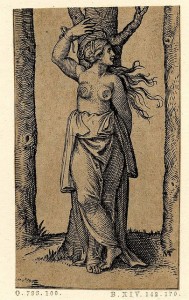Feast Day: February 5th
I hat to say it, but St. Agatha is known for her boobs.
Born in 231 in Catania, Sicily, St. Agatha is one of several 3rd-century virgin female martyrs with an outrageous, rather disturbing and likely fictitious life story; nevertheless, she seems to have been a real person. She died in 251 during the persecution of Christians by Roman Emperor Decius and is buried at the Badia di Sant’Agata in Catania.
Typically for saint legends (called hagiographic literature) from this era, she endured torture, but she never gave up her Christian faith and died as a consequence.
Also typical of these stories, St. Agatha was from a wealthy and noble family and she refused to get married. Quintianus, the guy she dissed, who happened to be a Roman prefect, was so irritated he sent her to live in a brothel that was run by a woman named Aphrodesia (awesome name) who eventually sends her to prison where she was tortured and someone cut off her breasts. No kidding.
She was supposed to be burned at the stake, but en earthquake put the kibosh on that, so she wound up in jail where St. Peter appeared to her in a vision and healed her wounds. She died there eventually, anyhow.
St. Agatha is one of only 7 women, including the Virgin Mary, who is commemorated in the Canon of the Mass.
St. Agnes is the patron saint of Catania, Molise, Malta, San Marino and Zamarramala in Spain. She also is the patron saint of breast cancer patients (makes sense), wet nurses (o.k.), bell founders (because of the shape of her severed breasts), bakers (loaves of bread look like boobs sometimes) and eruptions of Mt. Etna, from which she saved Catania with her miraculous veil, now housed in the Duomo in Florence, on the anniversary of her martyrdom (whatever).
St. Agatha’s attributes are shears, tongs and breasts on a plate.
St. Agatha in Art
Here St. Agatha holds one of her primary attributes, which is the pincers. These look like someone made them especially for chopping off boobs.
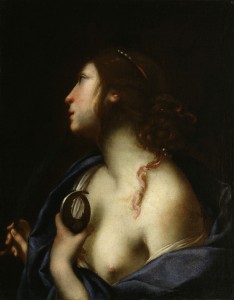
Francesco Furini, St. Agatha, c. 1640, oil and tempera on canvas, 25.3” x 19.8”, Walters Art Museum, Baltimore, Public Domain via Wikimedia Commons.
Here St. Agatha carries her tits on a plate. You see this a lot. Sometimes they look like fried eggs.
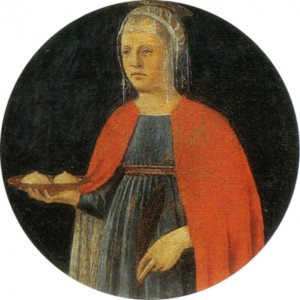
Piero della Francesca, St. Agatha from the Polyptych of St. Anthony, c. 1460-1470, oil on panel, 8.3” x 15.4”, National Gallery of Umbria, Perugia, Public Domain via Wikimedia Commons.
Here she is carrying her boob in some shears. Now you know why people associate bells with St. Agatha. It’s not obvious until you see it.

Israhel van Meckenem, St. Agatha, c. 1465, engraving, National Gallery of Art, Wahsington, D.C., NGA Images.
That is not nice.
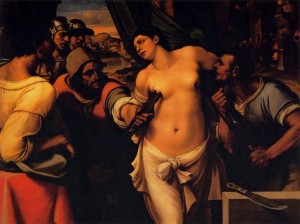
Sebastiano Del Piombo, Martyrdom of St. Agatha, 1520, oil on panel, 50” x 70.1”, Pitti Palace, Florence, Public Domain via Wikimedia Commons.
Here she is post chop.
St. Agatha looks pretty darn unhappy here. There is more than a little blood on her garment.
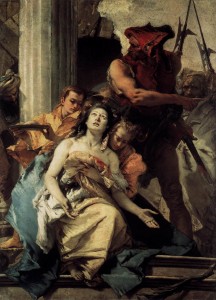
Giovanni Battista Tiepolo, The Martyrdom of St. Agatha, c. 1756, oil on canvas, 72.4” x 51.6”, Gemäldegalerie der Staatlichen Museen zu Berlin, Public Domain via Wikimedia Commons.
Here is St. Peter healing St. Agatha’s wounds. It’s nighttime and they are in jail. It’s rare to see this subject in art, probably because – let’s face it – it’s awkward.
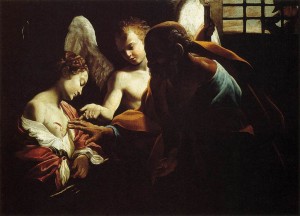
Giovanni Lanfraco, St. Peter Healing St. Agatha, c. 1614, oil on canvas, 39.4” x 52.4”, Galleria nazionale di Parma, Public Domain via Wikimedia Commons.
Oh Myyy!
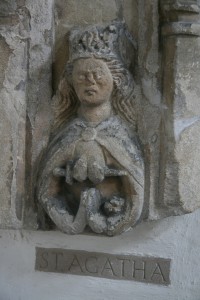
St Agatha at St Lawrence, Lechlade, Photo by Peter Reed via Flickr, Creative Commons Attribution-NonCommercial 2.0 Generic License.
Here is a St. Agatha cake baked for the feast day of the virgin saint. It’s supposed to look like a boob and I believe it succeeds.

Agatha Cake, Photo by girlinblack via Flickr, Creative Commons Attribution Attribution-NonCommercial-ShareAlike 2.0 Generic License.
If you wan to buy some things with St. Agatha on them, click here.
